The most reliable heating devices! Heating radiators: comparative characteristics and technical parameters
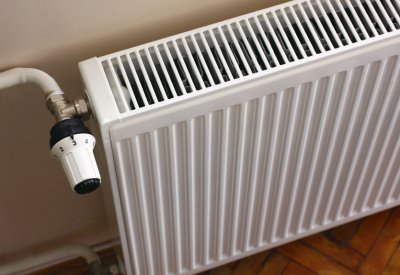
The dimensions of the heating device influence the choice when purchasing. For a house with small rooms, it would simply be unreasonable to purchase a large and expensive multi-section radiator, and in a mansion, a small battery will not heat anything.
It is important to choose a radiator proportionate to the area of the room: for example, in a one-room apartment every meter counts, so a heavy heater will be a big nuisance there.
Types of heating radiators and their comparative characteristics
The size of the heating device is a significant characteristic, which is paid attention to when choosing, as it determines the power and the space occupied in the room.
Standard
In addition to their sizes, heating radiators also differ in the material they are made from.

Photo 1. Standard size bimetallic radiators. Such devices are usually installed in apartments.
Cast iron
Heating systems common in Soviet times, which remain in communal apartments and in the 21st century - cast iron batteries. Characteristics of standard cast iron products:
- average height - 50-60 cm.;
- length of one section — 7-8 cm.;
- power limit - 0.15-0.17 kW;
- working pressure — 9-10 atmospheres.
Aluminum plate
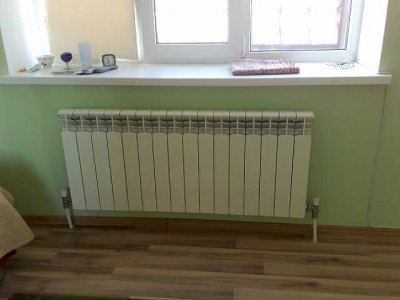
The material of such heaters quickly transfers heat from the liquid into the room.
In addition, these devices are much lighter than cast iron heating systems, and the flat plates of the body look much more modern. But their dimensions are similar, The differences are revealed in the technical characteristics:
- average height - 60-70 cm.;
- the length of one component part - 7-8 cm;
- thermal ceiling - 0.17-0.19 kW;
- working pressure — 16 atmospheres.
Bimetallic
These radiators are externally no different from aluminum ones., since the body is made of the same material, but inside them there are steel tubes that protect the structure from water hammer, high pressure and improve thermal conductivity.
Characteristics of standard models:
- the height of the section and, accordingly, the whole product — 40-50 cm.;
- length of component part — 8 cm.;
- maximum power - 0.19-0.21 kW;
- withstandable pressure during operation — 20-35 atmospheres.
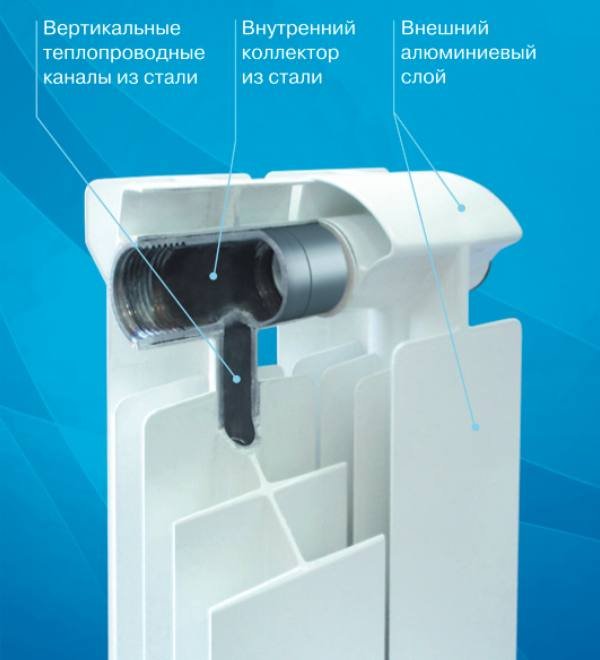
Photo 2. Construction of a bimetallic heating radiator. The arrows indicate the components of the device.
Low
Low radiators are the most compact of all types of radiator devices.
Cast iron
Since such products were manufactured according to strict standards, their sizes do not differ in variety. Neat cast iron radiators of small sizes are made to order using the figure casting method. Dimensions and values:
- section height — 40-50 cm.;
- length of component part — 5-6 cm.;
- thermal ceiling - 0.09-0.11 kW;
- working pressure — 9 atmospheres.
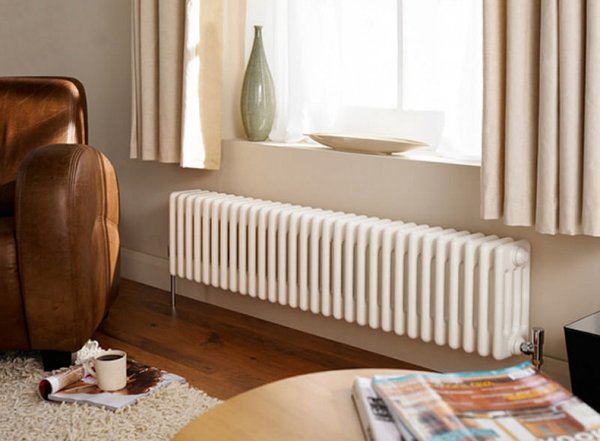
Photo 3. Low radiator made of cast iron. The device is white with a fairly modern design.
Aluminum
Small aluminum radiators are much more common, as production has not been going on for very long and technology continues to improve. Their small size determines the scope of their use: Such devices are installed in kindergartens, utility rooms, heated garages, attics and verandas. Specifications:
- height - 50 cm.;
- section length — 6-7 cm.;
- temperature maximum - 0.11-0.13 kW;
- working pressure — up to 16 atm.
Bimetallic

The scope of application of small-sized bimetallic heaters is limited to the same category of room types as those presented by aluminum devices.
Complements the list of office space at considerable heights — due to high pressure in the pipes of skyscrapers and business centers. Specifications:
- product height — 30-40 cm;
- length of one section — 6-7 cm.;
- power ceiling - 0.12-0.14 kW;
- withstandable pressure during operation — up to 28-32 atmospheres.
Tall
This type of device is also quite popular.
Cast iron
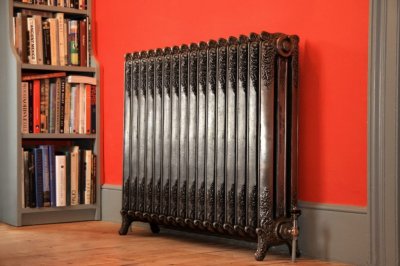
Here the sizes of cast iron products are not much different from other categories: All factory models are standard in size, as they were produced according to GOSTs.
Tall cast iron radiators are purchased from specialized foundries (not so cheap). Characteristics of devices of this type:
- height of the heating system body — 80-90 cm.;
- length of one section — 7-8 cm.;
- temperature ceiling — 0.18-0.21 kW;
- maximum pressure - about 9-12 atmospheres.
Aluminum
Here the choice is much wider: for tight spaces where long radiators won't fit, it's better to buy narrow but tall aluminum models. They usually have only 4 components, but this is fully compensated by their length. Specifications:
- Product height - up to two meters.
- Section length - about 10-12 cm.
- Maximum power - 0.40-0.45 kW.
- Pressure ~ 6 atmospheres.
Attention! This type of radiator is strictly prohibited to use. in central heating systems — the battery simply won’t withstand such pressure.
Bimetallic
The steel core of bimetallic batteries does not allow them to be made very high, since the circulation of water through it will be difficult.
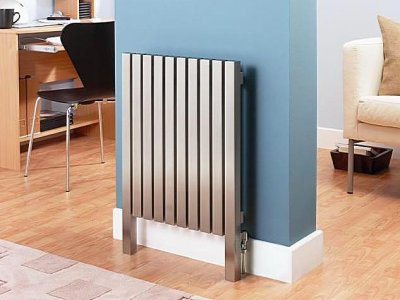
However, even a size half that of its all-aluminum counterpart is enough to heat a spacious room. And the value of the maximum pressure level is simply amazing:
- Height of the heating system ~ 80—90 cm.
- Length of component part — 7-8 cm.
- Thermal ceiling - 0.18-0.22 kW.
- Working pressure - from 20 to 100 atmospheres.
Technical parameters of batteries
Each radiator has its own technical and design features that allow some models to heat the room faster, while others, for example, consume less coolant. The ratio of these characteristics of a product that the buyer needs often determines his choice:
- Power
The larger the device and the higher the number of sections in it, the greater the power. This characteristic determines the quality of the heat transfer of the battery. But high power means high energy consumption, so you will have to pay for the use of more electricity for efficient heating.
- Pressure
The value of the working pressure level varies greatly among radiator models: from 6 to 100 atmospheres. The higher this indicator, the better the product withstands water hammer. In addition, a device that can withstand from 16 atmospheres, can be installed in the central heating network.
- Temperature
It depends on how much the coolant heats up inside the working area (according to SNIPam, this value cannot be exceeded 95 °C). For example, the surface temperature of oil radiators reaches 150 °C, while in most centralized and autonomous heating systems the value of the coolant temperature does not exceed 100 °C.

- Heat dissipation
This is one of the most important characteristics of any radiator, as it determines how quickly and efficiently the device will heat the air in the room.
The highest heat transfer levels are found in products with convectors and wide heat-dissipating plate casings.
- Heating the room
Here there is a direct dependence on the first and fourth characteristics. The more powerful the battery and the higher the heat output level, the faster it will heat the entire room to the temperature required by the homeowner.
Important! It is practically useless to heat poorly insulated room — even the most powerful heating systems will not help here. Before installing a radiator in a house, garage, apartment or any other room, it is important to make sure that hot air will not escape from cracks in the walls or windows.
Temperature norm
There is only a standard for the temperature of the coolant in the centralized heating system - it should not rise above 95 °C. But the lower threshold standards are not established anywhere, and public utilities are guided by a government regulation: the temperature in a residential area should not drop below 18 °C. On average, the temperature during the heating season should remain at the level 60—70 °C, to provide the necessary 18—20 °C in the house.
Useful video
Watch the video to learn how to choose the right heating radiator.
A thoughtful choice
There is a clear overpayment both for the radiator itself and for its further maintenance, if the choice of the heating system is not carefully considered. To save money and ensure efficient operation of the product in the homeowner's premises When choosing a battery, all its technical characteristics are taken into account And design characteristics.







